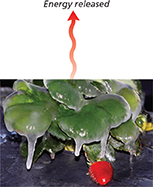Energy and Phase Changes
During a phase change, energy is transferred between a substance and its surroundings. The direction of the transfer depends on the type of phase change.  Energy is either absorbed or released during a phase change.
Energy is either absorbed or released during a phase change.
The ice sculpture in Figure 18 isn't going to last forever. When the temperature of the air rises above 0°C or when sunlight shines directly on the ice, an ice sculpture begins to melt. Melting is an example of an endothermic change. During an endothermic change, the system absorbs energy from its surroundings.
The amount of energy absorbed depends on the substance. For example, one gram of ice absorbs 334 joules (J) of energy as it melts. This amount of energy is the heat of fusion for water. Fusion is another term for melting. The heat of fusion varies from substance to substance.
One gram of water releases 334 joules of energy to its surroundings as it freezes, the same amount of energy that is absorbed when one gram of ice melts. Farmers use this release of energy to protect their crops. When farmers expect temperatures to drop slightly below 0°C, they spray the crops with water as shown in Figure 19. As water freezes, it releases heat. The flow of heat slows the drop in temperature and helps protect the crops from damage. Freezing is an example of an exothermic change. During an exothermic change, the system releases energy to its surroundings.
An understanding of phase changes can be useful in many situations. The How It Works box explains how the design of an ice rink in Utah allows the manager of the rink to control the hardness of the ice.
Figure 18 This elaborate ice sculpture was carved in Asahikawa, Japan. The ice sculpture will start to melt if the temperature rises above 0°C or sunlight shines directly on the ice.

Figure 19 As ice forms on this strawberry plant, the energy released keeps the plant from freezing at temperatures slightly below 0°C. Applying Concepts Explain why a farmer would need to keep spraying the plant with water while the temperature remains below freezing.


How much energy does one gram of ice absorb as it melts?




